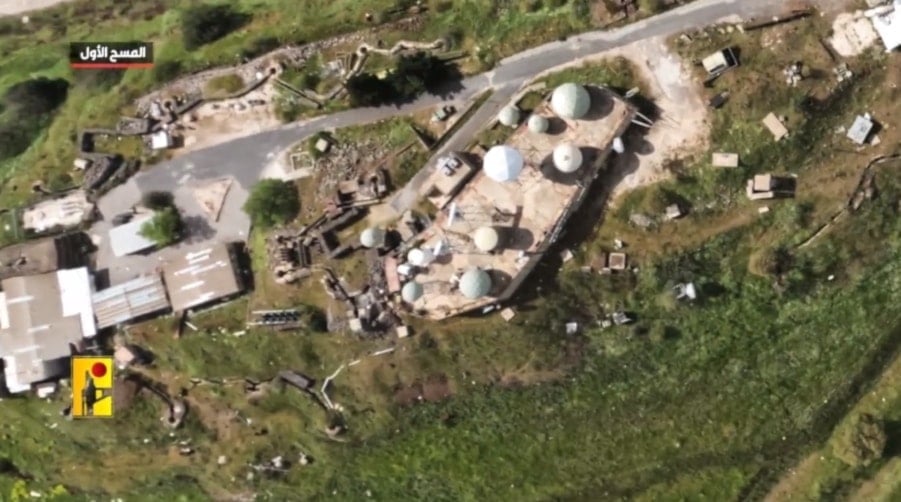'Israel' reacts to Hoopoe, part 2: Where were the Air Defenses?
Reviewing episode two of the Hoopoe series released by Hezbollah, Israeli media demands answers and reports on the settlers' reactions to the Resistance's capabilities.
-

Footage from the second episode of the Hoopoe series, published by the Islamic Resistance in Lebanon, Hezbollah, on July 9, 2024 (Military Media)
After the Islamic Resistance in Lebanon - Hezbollah - released the second episode of the Hoopoe (al-Hodhod) series, featuring high-resolution aerial reconnaissance footage of intelligence bases, command centers, and camps belonging to the Israeli occupation forces in the occupied Syrian Golan, Israeli media rushed to report back on its connotations.
Detailing the Israeli occupation's reactions, Israeli Channel 12 said the Hoopoe episode proves that Hezbollah is directing psychological warfare alongside the military war launched on the northern front.
Israeli media stated that Hezbollah managed to capture some of the most sensitive sites in "Israel", particularly the occupied North, in only 10 minutes, with its reconnaissance drones filming tens of areas and facilities.
In a striking comment, Israeli media said the video represented a "new worrying documentation, as it is documenting the eye of the state of Israel" and "explicitly shows six strategic locations."
The Military Media of the Islamic Resistance in #Lebanon published part II of the #Hoopoe video showcasing footage of a reconnaissance drone surveilling vital and sensitive regions in occupied Syrian territory, Golan.
— Al Mayadeen English (@MayadeenEnglish) July 9, 2024
1/6 pic.twitter.com/QGkZoTjXnk
It's not just observing 'Israel' from above
In the same context, the occupation's media added that Hezbollah "published maps and images of the military sites it targeted over the past nine months in the Golan," which affirms that it possesses "greater abilities" and could "launch swarms of drones, and it would in the event of a wide-scale war."
The Israeli expert on national security affairs, Kobi Marom, told Channel 12 that the Hoopoe video is another type of battle, and shows the extent of capabilities Hezbollah possesses," while simultaneously noting the Israeli occupation's inability to intercept Hezbollah's drones.
Israeli media further wondered how many more F-35 fighter jets "Israel" has to acquire to be able to stop Hezbollah's jets, while the military affairs expert at the Israeli Walla! website made remarks against the Israeli Air Defenses, asking "Where were they?"
Hezbollah deters 'Israel'
The military correspondent at the Israeli Makor Rishon newspaper, Noam Amir, clarified that "It is not only that they could see Israel from above, but there is also information on the areas of deployment of the Israeli army," which explains how "Hezbollah is capable of striking areas where soldiers are gathered, and cause casualties among them."
Regarding the Lebanese Resistance's goal behind publishing the Hoopoe video, Amir said the objective of such scenes was to "deter the security and military establishment, as well as the Israeli audience against any war with Hezbollah."
The military correspondent further stated that the Resistance's drones have been infiltrating "Israel" for the past nine months, while the Secretary-General of Hezbollah, Sayyed Hassan Nasrallah, gathered intel to be used for deterrence.
Channel 12's correspondent in the occupied north also said the video's objective was to relay a message saying "We know where we are attacking, and we where we can reach."
Anxiety among Israeli settlers
Israeli media, particularly Channel 12, also reported on how the scenes reflected the Israeli settlers' anxiety, especially those living in northern settlements, saying "The video and the scenes published by Hezbollah were conflicting and extremely worrying."
It was highlighted that what worried the settlers the most, was a Hezbollah drone that infiltrated inhabited settlements, such as Nahariya, Akka, Afula, and the occupied Golan, without being intercepted.
Israeli media tried to determine the timing of the drone's infiltration but found that "it was not entirely clear," however, noticing that the snow atop the Golan mountains had partially melted, it could be estimated that the scenes were taken after winter ended.
However, in one of the scenes, Hezbollah indicates that one of the documented military sites was a bade developed in June.
Strategic sites
Episode two of the Hoopoe series showcased footage of six strategic electronic reconnaissance sites in the occupied Syrian Golan; the Western and Eastern Shlagim sites, the Astra site, the Yisraeli site, the Avital site, and the Tal Fares site.
According to the information provided in the video, these Israeli sites are tasked with espionage, guidance, long-range monitoring, and electronic attacks involving jamming and deception.
Moreover, the sites contain key nodes for communications and data exchange and house forces from the 8200 and 9900 units, as well as the electronic warfare unit.
Additionally, the six Israeli sites include forces responsible for securing the bases, their equipment, and the border area. It is noteworthy that the intelligence and early warning bases filmed by Hezbollah's Hoopoe are referred to as "the eyes of the state of Israel," and the footage released included multiple scans of these sites.
Additionally, the footage revealed command centers and camps belonging to the Israeli occupation military, as well as new points and roads for Israeli forces outside the aforementioned sites, established during Operation Al-Aqsa Flood, along with fortified shelters for soldiers.

 5 Min Read
5 Min Read








